2. The retrovirus life cycle involves transpositionVlike events
16.2 The retrovirus life cycle involves transposition Vlike events |
| Key terms defined in this section |
| LTR is an abbreviation for long-terminal repeat. |
Retroviruses have genomes of single-stranded RNA that are replicated through a double-stranded DNA intermediate. The life cycle of the virus involves an obligatory stage in which the double-stranded DNA is inserted into the host genome by a transposition-like event that generates short direct repeats of target DNA (for review see Varmus and Brown, 1989).
The significance of this reaction extends beyond the perpetuation of the virus. Some of its consequences are that:
- A retroviral sequence that is integrated in the germline remains in the cellular genome as an endogenous provirus. Like a lysogenic bacteriophage, a provirus behaves as part of the genetic material of the organism.
- Cellular sequences occasionally recombine with the retroviral sequence and then are transposed with it; these sequences may be inserted into the genome as duplex sequences in new locations.
- Cellular sequences that are transposed by a retrovirus may change the properties of a cell that becomes infected with the virus.
 |
Figure 16.2 The retroviral life cycle proceeds by reverse transcribing the RNA genome into duplex DNA, which is inserted into the host genome, in order to be transcribed into RNA. |
The particulars of the retroviral life cycle are expanded in Figure 16.2. The crucial steps are that the viral RNA is converted into DNA, the DNA becomes integrated into the host genome, and then the DNA provirus is transcribed into RNA.
The enzyme responsible for generating the initial DNA copy of the RNA is reverse transcriptase. The enzyme converts the RNA into a linear duplex of DNA in the cytoplasm of the infected cell. (The DNA also is converted into circular forms, but these do not appear to be involved in reproduction (Temin and Mizutani, 1970; Baltimore, 1970).
The linear DNA makes its way to the nucleus. One or more DNA copies become integrated into the host genome. A single enzyme, called integrase, is responsible for integration. The integrated proviral DNA is transcribed by the host machinery to produce viral RNAs, which serve both as mRNAs and as genomes for packaging into virions. Integration is a normal part of the life cycle and is necessary for transcription.
Two copies of the RNA genome are packaged into each virion, making the individual virus particle effectively diploid. When a cell is simultaneously infected by two different but related viruses, it is possible to generate heterozygous virus particles carrying one genome of each type. The diploidy may be important in allowing the virus to acquire cellular sequences. The enzymes reverse transcriptase and integrase are carried with the genome in the viral particle.
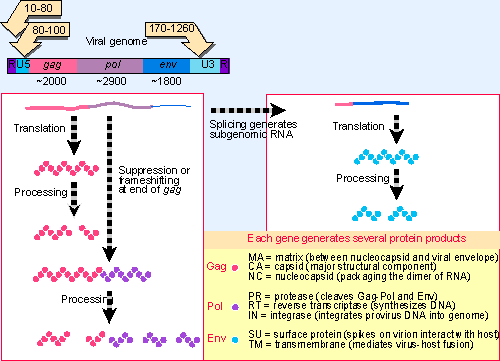 |
Figure 16.3 The genes of the retrovirus are expressed as polyproteins that are processed into individual products. |
A typical retroviral sequence contains three or four "genes," the term here identifying coding regions each of which actually gives rise to multiple proteins by processing reactions. A typical retrovirus genome with three genes is organized in the sequence gag Vpol Venv as indicated in Figure 16.3.
Retroviral mRNA has a conventional structure; it is capped at the 5′ end and polyadenylated at the 3′ end. It is represented in two mRNAs. The full length mRNA is translated to give the Gag and Pol polyproteins. The Gag product is translated by reading from the initiation codon to the first termination codon. This termination codon must be bypassed to express Pol.
Different mechanisms are used in different viruses to proceed beyond the gag termination codon, depending on the relationship between the gag and pol reading frames. When gag and pol follow continuously, suppression by a glutamyl-tRNA that recognizes the termination codon allows a single protein to be generated. When gag and pol are in different reading frames, a ribosomal frameshift occurs to generate a single protein. Usually the readthrough is ~5% efficient, so Gag protein outnumbers Gag VPol protein about 20 Vfold.
The Env polyprotein is expressed by another means: splicing generates a shorter subgenomic messenger that is translated into the Env product.
The gag gene gives rise to the protein components of the nucleoprotein core of the virion. The pol gene codes for functions concerned with nucleic acid synthesis and recombination. The env gene codes for components of the envelope of the particle, which also sequesters components from the cellular cytoplasmic membrane.
Both the Gag or Gag VPol and the Env products are polyproteins that are cleaved by a protease to release the individual proteins that are found in mature virions. The protease activity is coded by the virus in various forms: it may be part of Gag or Pol, or sometimes takes the form of an additional independent reading frame
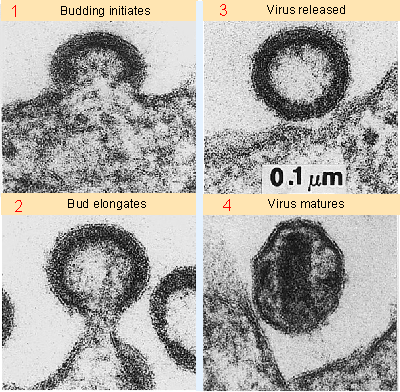 |
Figure 16.4 Retroviruses (HIV) bud from the plasma membrane of an infected cell. Photograph kindly provided by Matthew Gonda. Multiple figure |
The production of a retroviral particle involves packaging the RNA into a core, surrounding it with capsid proteins, and pinching off a segment of membrane from the host cell. The release of infective particles by such means is shown in Figure 16.4. The process is reversed during infection; a virus infects a new host cell by fusing with the plasma membrane and then releasing the contents of the virion.
Retroviruses are called plus strand viruses, because the viral RNA itself codes for the protein products. As its name implies, reverse transcriptase is responsible for converting the genome (plus strand RNA) into a complementary DNA strand, which is called the minus strand DNA. Reverse transcriptase also catalyzes subsequent stages in the production of duplex DNA. It has a DNA polymerase activity, which enables it to synthesize a duplex DNA from the single-stranded reverse transcript of the RNA. The second DNA strand in this duplex is called plus strand DNA. And as a necessary adjunct to this activity, the enzyme has an RNAase H activity, which can degrade the RNA part of the RNA VDNA hybrid. All retroviral reverse transcriptases share considerable similarities of amino acid sequence, and homologous sequences can be recognized in some other retroposons (see later; for review see Katz and Skalka, 1994).
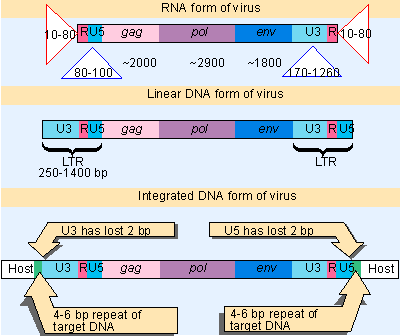 |
Figure 16.5 Retroviral RNA ends in direct repeats (R), the free linear DNA ends in LTRs, and the provirus ends in LTRs that are shortened by two bases each. |
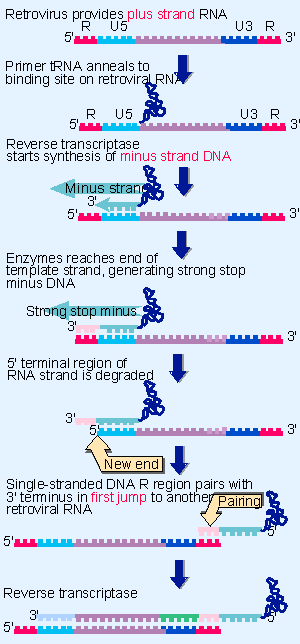 |
Figure 16.6 Minus strand DNA is generated by switching templates during reverse transcription. |
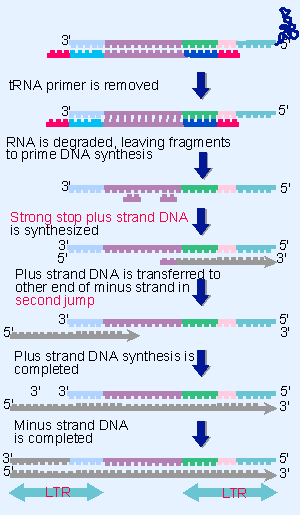 |
Figure 16.7 Synthesis of plus strand DNA requires a second jump. |
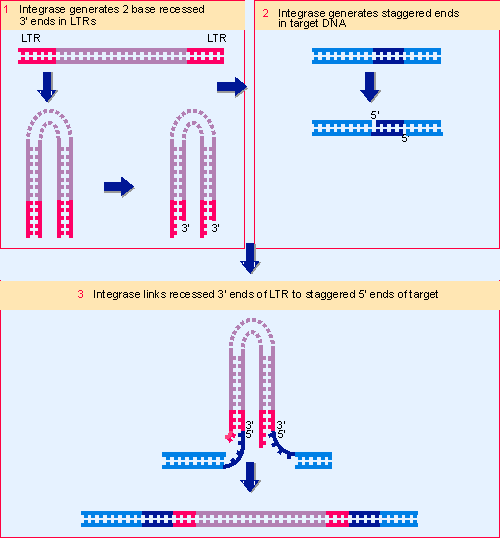 |
Figure 16.9 Integrase is the only viral protein required for the integration reaction, in which each LTR loses 2 bp and is inserted between 4 bp repeats of target DNA. |
The structures of the DNA forms of the virus are compared with the RNA in Figure 16.5. The viral RNA has direct repeats at its ends. These R segments vary in different strains of virus from 10 V80 nucleotides. The sequence at the 5′ end of the virus is R-U5 , and the sequence at the 3′ end is U3-R. The R segments are used during the conversion from the RNA to the DNA form to generate the more extensive direct repeats that are found in linear DNA (see Figure 16.6 and Figure 16.7). The shortening of 2 bp at each end in the integrated form is a consequence of the mechanism of integration (see Figure 16.9).
Like other DNA polymerases, reverse transcriptase requires a primer. The native primer is tRNA. An uncharged host tRNA is present in the virion. A sequence of 18 bases at the 3′ end of the tRNA is base paired to a site 100 V200 bases from the 5′ end of one of the viral RNA molecules. The tRNA may also be base paired to another site near the 5′ end of the other viral RNA, thus assisting in dimer formation between the viral RNAs.
Here is a dilemma. Reverse transcriptase starts to synthesize DNA at a site only 100 V200 bases downstream from the 5′ end. How can DNA be generated to represent the intact RNA genome? (This is an extreme variant of the general problem in replicating the ends of any linear nucleic acid; see 12 The replicon.)
Synthesis in vitro proceeds to the end, generating a short DNA sequence called minus strong-stop DNA. This molecule is not found in vivo because synthesis continues by the reaction illustrated in Figure 16.6. Reverse transcriptase switches templates, carrying the nascent DNA with it to the new template. This is the first of two jumps between templates.
In this reaction, the R region at the 5′ terminus of the RNA template is degraded by the RNAase H activity of reverse transcriptase. Its removal allows the R region at a 3′ end to base pair with the newly synthesized DNA. Then reverse transcription continues through the U3 region into the body of the RNA.
The source of the R region that pairs with the strong stop minus DNA can be either the 3′ end of the same RNA molecule (intramolecular pairing) or the 3′ end of a different RNA molecule (intermolecular pairing). The switch to a different RNA template is used in the figure because there is evidence that the sequence of the tRNA primer is not inherited in a retroposon life cycle. (If intramolecular pairing occurred, we would expect the sequence to be inherited, because it would provide the only source for the primer binding sequence in the next cycle. Intermolecular pairing allows another retroviral RNA to provide this sequence.)
The result of the switch and extension is to add a U3 segment to the 5′ end. The stretch of sequence U3 VR VU5 is called the long terminal repeat (LTR) because a similar series of events adds a U5 segment to the 3′ end, giving it the same structure of U5 VR VU3. Its length varies from 250-1400 bp (see Figure 16.5).
We now need to generate the plus strand of DNA and to generate the LTR at the other end. The reaction is shown in Figure 16.7. Reverse transcriptase primes synthesis of plus strand DNA from a fragment of RNA that is left after degrading the original RNA molecule. A strong stop plus strand DNA is generated when the enzyme reaches the end of the template. This DNA is then transferred to the other end of a minus strand. Probably it is released by a displacement reaction when a second round of DNA synthesis occurs from a primer fragment farther upstream (to its left in the figure). It uses the R region to pair with the 3′ end of a minus strand DNA. This double-stranded DNA then requires completion of both strands to generate a duplex LTR at each end.
Each retroviral particle carries two RNA genomes. This makes it possible for recombination to occur during a viral life cycle. Probably two events are involved, one during minus strand synthesis and one during plus strand synthesis:
- The intermolecular pairing shown in Figure 16.6 allows a recombination to occur between sequences of the two successive RNA templates when minus strand DNA is synthesized.
- Plus strand DNA may be synthesized discontinuously, in a reaction that involves several internal initiations. Strand transfer during this reaction can also occur.
The common feature of both events is that recombination results from a change in the template during the act of DNA synthesis. This is a general example of a mechanism for recombination called copy choice. For many years this was regarded as a possible mechanism for general recombination. It is unlikely to be employed by cellular systems, but is a common basis for recombination during infection by RNA viruses, including those that replicate exclusively through RNA forms, such as poliovirus (Hu and Temin, 1990; for review see Lai, 1992).
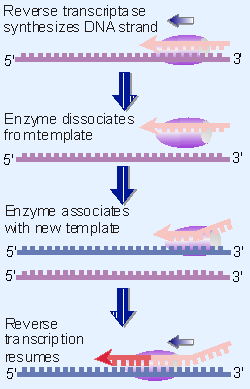 |
Figure 16.8 Copy choice recombination occurs when reverse transcriptase releases its template and resumes DNA synthesis using a new template. Transfer between template strands is probably occurs directly, but is shown here in separate steps to illustrate the process. |
Strand switching occurs with a certain frequency during each cycle of reverse transcription, that is, in addition to the transfer reaction that if forced at the end of the template strand. The principle is illustrated in Figure 16.8, although we do not know much about the mechanism. Reverse transcription in vivo occurs in a ribonucleoprotein complex, in which the RNA tempkate strand is bound to virion components, including the major protein of the capsid. In the case of HIV, addition of this protein (NCp7) to an in vitro system causes recombination to occur (Negroni and Buc, 2000). The effect is probably indirect: NCp7 affects the structure of the RNA template, which in turn affects the likelihood that reverse transcriptase will switch from one template strand to another.
The organization of the integrated provirus resembles that of the linear DNA. The LTRs at each end of the provirus are identical. The 3′ end of U5 consists of a short inverted repeat relative to the 5′ end of U3, so the LTR itself ends in short inverted repeats. The integrated proviral DNA is like a transposon: the proviral sequence ends in inverted repeats and is flanked by short direct repeats of target DNA.
The provirus is generated by directly inserting a linear DNA into a target site. (In addition to linear DNA, there are circular forms of the viral sequences. One has two adjacent LTR sequences generated by joining the linear ends. The other has only one LTR [presumably generated by a recombination event and actually comprising the majority of circles]. Although for a long time it appeared that the intermediate is a circle [by analogy with the integration of lambda DNA], we now know that the linear form is used for integration; for review see Goff, 1992).
Integration of linear DNA is catalyzed by a single viral product, the integrase. Integrase acts on both the retroviral linear DNA and the target DNA. The reaction is illustrated in Figure 16.9.
The ends of the viral DNA are important; as is the case with transposons, mutations in the ends prevent integration. The most conserved feature is the presence of the dinucleotide sequence CA close to the end of each inverted repeat. The integrase brings the ends of the linear DNA together in a ribonucleoprotein complex, and converts the blunt ends into recessed ends by removing the bases beyond the conserved CA; usually this involves loss of 2 bases (see below) (Craigie et al., 1990).
Target sites are chosen at random with respect to sequence. The integrase makes staggered cuts at a target site. In the example of Figure 16.9, the cuts are separated by 4 bp. The length of the target repeat depends on the particular virus; it may be 4, 5, or 6 bp. Presumably it is determined by the geometry of the reaction of integrase with target DNA.
The 5′ ends generated by the cleavage of target DNA are covalently joined to the 3′ recessed ends of the viral DNA. At this point, both termini of the viral DNA are joined by one strand to the target DNA. The single-stranded region is repaired by enzymes of the host cell, and in the course of this reaction the protruding 2 bases at each 5′ end of the viral DNA are removed. The result is that the integrated viral DNA has lost 2 bp at each LTR; this corresponds to the loss of 2 bp from the left end of the 5′ terminal U3 and loss of 2 bp from the right end of the 3′ terminal U5. There is a characteristic short direct repeat of target DNA at each end of the integrated retroviral genome.
The viral DNA integrates into the host genome at randomly selected sites. A successfully infected cell gains 1 V10 copies of the provirus. (An infectious virus enters the cytoplasm, of course, but the DNA form becomes integrated into the genome in the nucleus. Retroviruses can replicate only in proliferating cells, because entry into the nucleus requires the cell to pass through mitosis, when the viral genome gains access to the nuclear material.)
The U3 region of each LTR carries a promoter. The promoter in the left LTR is responsible for initiating transcription of the provirus. Recall that the generation of proviral DNA is required to place the U3 sequence at the left LTR; so we see that the promoter is in fact generated by the conversion of the RNA into duplex DNA.
Sometimes (probably rather rarely), the promoter in the right LTR sponsors transcription of the host sequences that are adjacent to the site of integration. The LTR also carries an enhancer (a sequence that activates promoters in the vicinity) that can act on cellular as well as viral sequences. Integration of a retrovirus can be responsible for converting a host cell into a tumorigenic state when certain types of genes are activated in this way (see 28 Oncogenes and cancer).
Can integrated proviruses be excised from the genome? Homologous recombination could take place between the LTRs of a provirus; solitary LTRs that could be relics of an excision event are present in some cellular genomes.
We have dealt so far with retroviruses in terms of the infective cycle, in which integration is necessary for the production of further copies of the RNA. However, when a viral DNA integrates in a germline cell, it becomes an inherited "endogenous provirus" of the organism. Endogenous viruses usually are not expressed, but sometimes they are activated by external events, such as infection with another virus.
Wu, 1978; Drake and Balz, 1976
| Reviews | |
| Drake, J. W. and Balz, R. H. (1976). The biochemistry of mutagenesis. Ann. Rev. Biochem 45, 11-37. | |
| Goff, S. P. (1992). Genetics of retroviral integration. Ann. Rev. Genet. 26, 527-544. | |
| Katz, R. A. and Skalka, A. M. (1994). The retroviral enzymes. Ann. Rev. Biochem 63, 133-173. | |
| Lai, M. M. C. (1992). RNA recombination in animal and plant viruses. Microbiol. Rev. 56, 61-79. | |
| Varmus, H. and Brown, P. (1989). Retroviruses. In Mobile DNA, Eds. Berg, D. E. and Howe, M. American Society of Microbiology, Washington DC 3-108. | |
| Wu, R. (1978). DNA sequence analysis. Ann. Rev. Biochem 47, 607-734. | |
| Research | |
| Baltimore, D. (1970). RNA-dependent DNA polymerase in virions of RNA tumor viruses. Nature 226, 1209-1211. | |
| Craigie, R., Fujiwara, T., and Bushman, F. (1990). The IN protein of Moloney murine leukemia virus processes the viral DNA ends and accomplishes their integration in vitro. Cell 62, 829-837. | |
| Hu, W. S. and Temin, H. M. (1990). Retroviral recombination and reverse transcription. Science 250, 1227-1233. | |
| Negroni, M. and Buc, H. (2000). Copy-choice recombination by reverse transcriptases: reshuffling of genetic markers mediated by RNA chaperones.. Proc. Nat. Acad. Sci. USA 97, 6385-6390. | |
| Temin, H. M. and Mizutani, S. (1970). RNA-dependent DNA polymerase in virions of Rous sarcoma virus. Nature 226, 1211-1213. | |